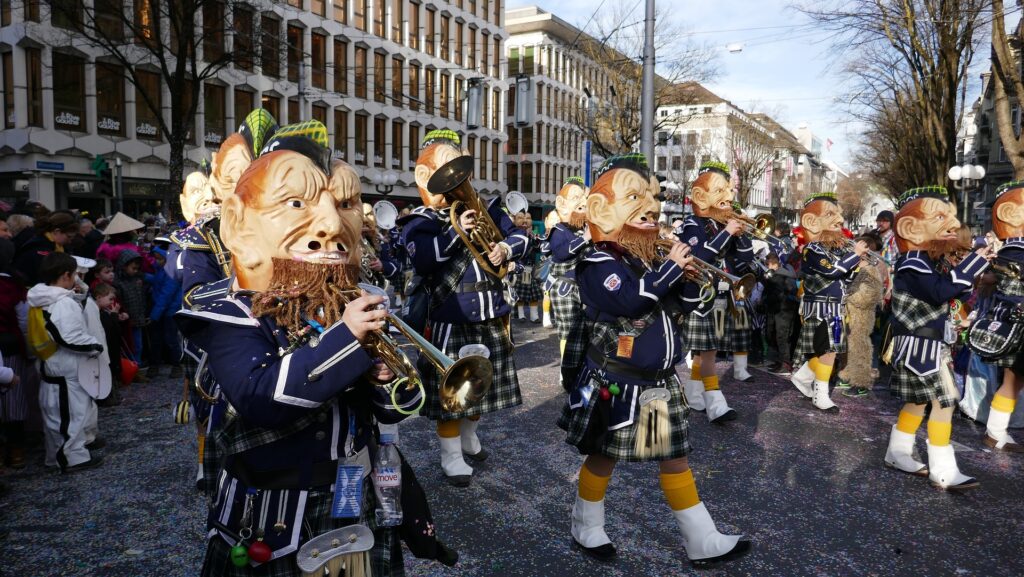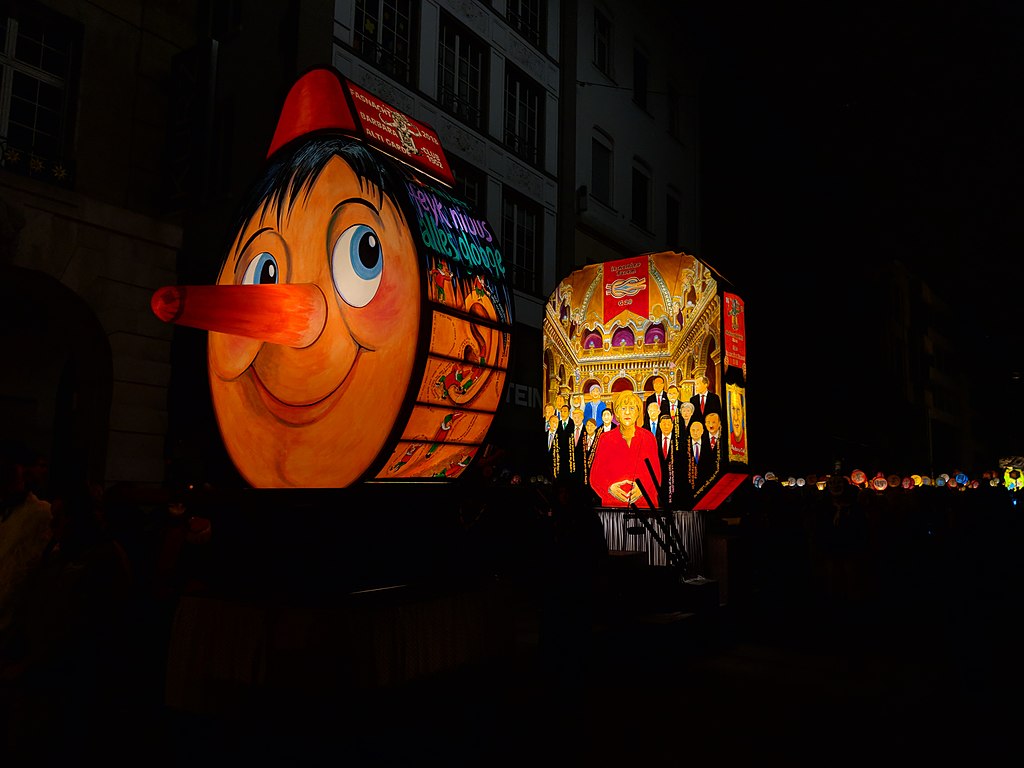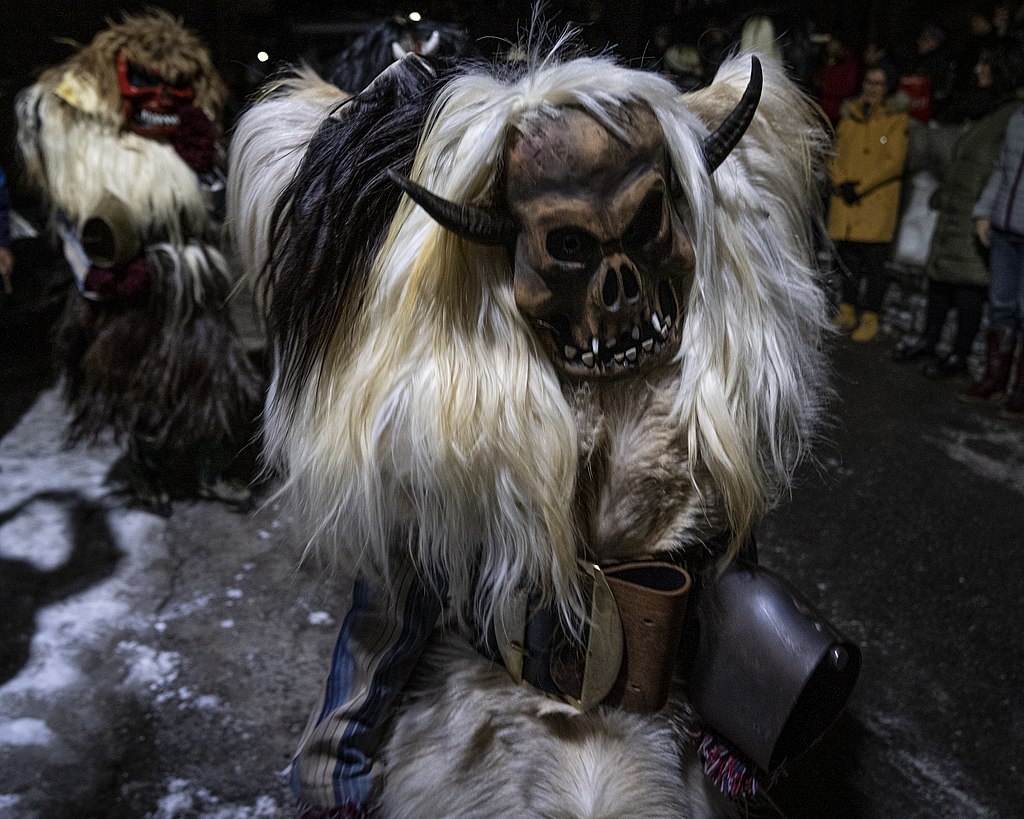History and traditions of the Swiss Carnival
Carnival is celebrated in many different ways: carnival parades, music, masks and dressing up play an important role.

The term ‘carnival’ derives from the Latin ‘carnem levare’ (i.e. to remove meat) and refers to the eve of Lent, the forty-day period of fasting before Easter, which begins on Ash Wednesday. The period of fasting recalls the 40 days of fasting and penance spent by Jesus in the desert.
During the Middle Ages, everyone in Christian Europe had to observe the obligation to fast and carnival was used to exhaust the last winter supplies, feast, dance and make music.
In many places in Catholic areas, carnival opens at 11.11 a.m. on 11 November. This date always has something to do with fasting, in fact, a period of fasting before Christmas used to be observed starting on St Martin’s Day. Because of the Bible’s ten commandments, moreover, the number eleven symbolised excess, overstepping boundaries and buffoonery. Real carnival parades and celebrations take place everywhere in February or March regardless of whether the carnival opens on St Martin’s Day or just before Ash Wednesday.
In Switzerland, carnival is one of the most popular festivities that takes place in practically every municipality and originates from a mixture of Christian rituals, traditional customs and pagan celebrations, even centuries old. Participants, wearing scary masks to ward off evil spirits and imaginative disguises, temporarily assume a new identity as they parade through the streets to the sound of music.
Of particular note are the carnivals of the City of Lucerne and Basel (the latter being part of the UNESCO intangible cultural heritage). In some cantons, Carnival is based on the pre-Christian custom of driving out winter and evil spirits to welcome the rebirth of spring.
The alpine season as candidate for the intangible cultural heritage of UNESCO
The night of St. Lawrence between traditions and legends
Schmutziger Donnerstag or Fat Thursday
Fat Thursday falls on the Thursday before Ash Wednesday and marks the beginning of the carnival season. ‘Schmutz’ (also ‘Schmotz’) is an Alemannic dialect term for fat and in the past, in order to survive Lent (from Ash Wednesday), people used to eat as much fat as possible on Fat Thursday.
Fasnachtsdienstag or Fat Tuesday
Also called Faschingsdienstag, or Karnevalsdienstag, in German-speaking countries, it is known as Fat Tuesday and marks the last day of carnival, before the beginning of Lent. In some regions where it is celebrated, it is the climax of carnival festivities.
The most famous and characteristic Swiss Carnivals
Basel Carnival
In the 16th century, Basel also adhered to the Protestant Reformation by abolishing the fasting period before Easter and with it the carnival; however, the authorities failed to impose themselves, so that this city is among the few Swiss Protestant cities where a traditional carnival is still celebrated today.
According to some local historians, the throwing of confetti is a typical Basel tradition that has since spread to the rest of the world. Originally, sweets called confetti were given or thrown to the crowd during the parade, but this practice was banned in the 19th century and replaced with small scraps of paper. In the Basel German dialect, confetti is called Räppli.

This Carnival has a history spanning centuries and was included in the UNESCO intangible cultural heritage in 2017 and is the largest in Switzerland. Starting at 4 a.m. on the Monday after Ash Wednesday, when the bells of St Martin’s Church ring out, all the lights in the town centre are switched off and the music and festivities begin at the command “Morgestraich, vorwärts marsch!” and the traditional melody of the Morgenstreich march is sung. In the completely darkened city, lanterns with representations of past carnival themes and accompanying drums shine. Many restaurants and bars in the old town also open their doors and remain open for the next 72 hours.
One of the oldest ensembles are the Cliques, which march through the old town playing the piccolo and basler drums: these consist of a Vortrab (vanguard), the Pfeifer (pipers), the Tambourmajor (drum major) and the Tambouren (drummers).
The Gugge (brass bands) play the Guggenmusik during Carnival by marching and playing and performing in the Guggekoncerts.
The Schnitzelbank singers are jesters who sing satirical verses in Swiss German about current events in Basel and around the world. The singers regularly perform in restaurants and bars on Monday and Wednesday evenings and in clique-cellars (local assembly halls) on Tuesdays.
On Monday and Wednesday afternoons, two large ‘Cortège‘ processions with masks, costumes and the traditional Guggenmusik take place, while Tuesday afternoon is dedicated to children, dressed in themed costumes and armed with confetti and candy. In the evening, it is time for music in the city’s main squares. Flour soup, onion cake and a caraway bretzel called ‘Fastenwähe’ accompany the three days of celebrations.
The city’s typical masks are the ‘Waggis‘, a character with a big nose and colourful clothes, and the ‘Alti Tante‘ (old aunt), an elegant Basel lady.
These three days of festivities are called ‘drey scheenschte Däägi‘ or the three most beautiful days of the year by the citizens of Basel.
St. Gallen Carnival
This carnival is famous for the ‘Föbü-Verschuss‘, where each year a new ‘honorary citizen’, i.e. the person who has done the craziest thing in the past year, is chosen in front of the statue of Vadiano. The choice is made by the Schnitzelbänkler (satirical storytellers), the Gugger and the carnival associations, and the name of the winner is announced with a cannon shot from which coloured confetti is fired.
Lucerne Carnival
This carnival is considered to be the biggest annual event in the city. It traditionally opens on Fat Thursday with the Fritschi arriving aboard a boat on Lake Lucerne at 5 a.m. to announce the opening of the carnival with a thunderous roar known as the ‘big bang’, which marks the start of the six-day celebration. The Fritschi, an old man accompanied by his wife and son, seems to take his origins from a symbolic figure from the past, a straw puppet called Fridolin.
In addition to the traditional throwing of oranges at the Fritschibrunnen, a long procession passes through the town.
The origin of this carnival is linked to the ritual to drive out winter. Masked music groups known as ‘Guggenmuusige’ give hilarious and noisy performances to make thousands of visitors dance and sing while mocking them. Highlights are the three big city parades: the Fritschiumzug on Shrove Thursday, the Weyumzug on Fat Monday and the Monstercorso on FatTuesday.
Solothurn Carnival
Solothurn in conjunction with St Hilary’s Day, 13 January, changes its name to Honolulu because a joker once claimed that the city on the River Aare was exactly the other side of the globe from Hawaii. This theory is still maintained to this day.
The mayor is dismissed and the street of the Town Hall is renamed ‘Donkey Street‘. The festivities last over a month and get into full swing at 5 o’clock on Shrove Thursday with the ‘Chesslete‘, the noisy procession of torches and deafening instruments that crosses the old town, waking those who sleep.
On the following evenings, especially on Saturdays, masked balls are held, while on Sundays and Tuesday afternoons, processions are held through the streets. A large brass band (Gugge) plays festive music on Tuesday evenings until the official closing, which takes place after the Böögg, or straw man, is burnt on Ash Wednesday evening.
Bellinzona Carnival
The Bellinzona Carnival, better known as Rabadan, is one of the main events in Ticino and lasts six days.
Carnival begins with the handing over of the keys of the city to King Rabadan, a Piedmontese term meaning “noise” that was apparently coined at the time of the Crusades to indicate the evening banquets after the daytime fast of Ramadan. The city is transformed into an open-air party, with Guggenmusik concerts in the old town offering music and entertainment until 5am and tug-of-war tournaments. Various stands offer risotto and luganighe. On Sunday, Bellinzona hosts the customary ‘Grande Corteo Mascherato‘, a parade with music, floats and masked groups.
Lötschental Carnival (Valais)
The Tschäggättä (a term that can be translated as ‘witch’) are typical carnival figures from the Lötschental (Valais).
The so-called Tschäggättä make their appearance between ‘Maria Lichtmess’ (the Catholic Candlemas feast) and ‘Gigiszischtag’ (FatTuesday).

It used to be that only single men wore these masks made of pine wood, goat or sheep skins and old-fashioned inverted clothing and cowbells called ‘Tschäggätta’. Today, however, married men also take part and local tourist boards promote this tradition to attract visitors from outside. Anyone who encounters them is chased and ‘haunted’ by these figures, who rub their gloves soaked in snow or soot onto the faces of the unfortunate (mainly women and children).
The ancient tradition brings with it a multitude of myths and stories. During the procession, one can admire these figures with their handmade masks, each with its own story to tell.
The ancient masks can also be admired in the Lötschental Museum.





